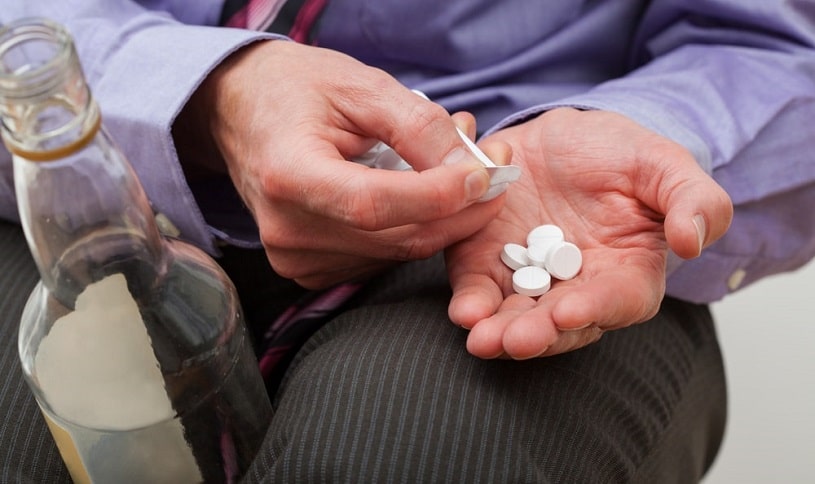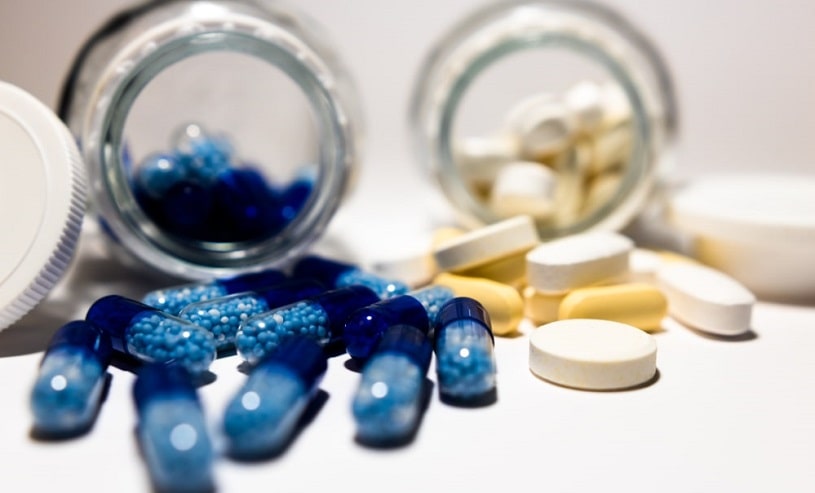In the treatment of moderate to severe pain, tramadol is a drug frequently used. As an opioid pain reliever, it comes with higher abuse potential, and it needs to be taken with care. There is the risk of addiction as well as overdose, which can be fatal.
Table Of Contents:
- What Are the Reasons People Combine Medications?
- Can Tramadol Interact with Alcohol?
- What Are the Side Effects of This Combination?
- What Are the Overdose and Addiction Dangers?
- Does This Drug Interact with Ibuprofen?
- Does This Drug Interact with Gabapentin?
- Can It Interact with Prozac?
- What Are Other Drug Interactions?
- How To Take Medications Safely?

Many people use the drug in combination with alcohol or other drugs and medications. Using tramadol and alcohol or other substances can result in certain undesirable tramadol interactions. This article will discuss those and their effects.
Why Do People Mix Drugs?
Drugs should not be combined except one has their doctor’s express permission. Despite this, many people mix drugs together.
They do this because they feel that combining drugs will have more significant effects than using a single medicine on its own. That is why some people will mix two analgesics like tramadol and ibuprofen.
However, there are dangers associated with combining drugs in such a manner. They can be minor, such as the effects taking longer to wear off, but they can also result in significant and potentially fatal consequences. People who indulge in mixing drugs may not be aware of this.
Tramadol and Alcohol
Tramadol is an opioid, and one of the most significant effects that opioids have is that they depress a person’s respiration due to the general depressive effect they have on the CNS. Alcohol similarly causes central nervous system depression.

When one takes tramadol with alcohol, these effects pair together for a more substantial effect. The danger in this is that it can cause a level of respiratory depression which can be fatal or cause significant brain damage due to oxygen deprivation. It is much easier to overdose on Tramadol when these drugs are combined.
Looking at visits to emergency departments, a study found that 14% of visits had tramadol and alcohol as culprits. Most of these people were under the age of 34.
In 2017, another study found that overdose deaths on opioids had alcohol involved 14.7% of the time.
Side Effects of Mixing with Alcohol
Several side effects might arise from using tramadol and alcohol together. Many of these effects are due to the fact it reduces CNS activity.
These Include:
- Slowed breathing: As earlier stated, both of these drugs cause CNS depression and, in turn, respiratory depression. It will result in reduced breathing, but when extreme can cause oxygen deprivation.
- Organ damage: Oxygen deprivation can starve organs of oxygen and cause damage as a result.
- Drowsiness: People who use these together can begin to feel drowsy or sleepy. It may be dangerous if they work in a very safety-intensive position, such as operating heavy machinery.
- Impaired muscle coordination: The reduced activity of the CNS means that signals from the brain to the muscles are not as quickly transferred. This can result in impaired coordination and reflexes.
- Coma: When the brain becomes deprived of oxygen for too long, cell death occurs. If this damage is severe enough, it can produce a comatose state.
- Death: If the heart or brain are deprived of oxygen, it can eventually result in death.
Overdose and Addiction
Overdose is a risk with any medication when it is taken in a large dosage. However, the risk of overdose with many medications is increased when it is combined with other substances. This is the case when using tramadol and alcohol.
Overdose Can Manifest With the Following Symptoms:
- Difficulty breathing
- Pinpoint pupils
- Severe drowsiness
- Cold, clammy skin
- Increased heart rate
- Severely impaired muscle coordination
Addiction to tramadol and alcohol can destroy a person’s life. Their life at work, school, and socially will fall apart. Addiction will also take a substantial financial and physical toll on them. Addiction can be challenging to get past and will usually require specialist medical help.
Tramadol and Ibuprofen
Mixing tramadol with ibuprofen is common practice as both of these medications are analgesics. People with severe pain may use these drugs in combination as they believe the effect will be more potent.
This is a correct notion, as has been proven by animal studies. While tramadol and ibuprofen are both analgesics, they work through different mechanisms. It can allow for more effective pain relief, mainly when one drug doesn’t do the job well enough.
However, it is essential to inform the doctor before using multiple drugs in such a manner. Medications like ibuprofen can cause gastrointestinal bleeding when used in individuals with certain risk factors.
Tramadol and Gabapentin
Gabapentin is a drug used in the treatment of seizures, though it is also actively used in the treatment of nerve pain. As a result, tramadol and gabapentin are frequently combined for analgesic purposes.
In an animal study, combining tramadol and gabapentin was shown to have a synergistic effect in managing pain, indicating that these drugs work more effectively in combination.
However, these drugs should only be combined with permission from a doctor. Gabapentin has a similar depressive effect on the respiratory system, so tramadol interactions with it can be severe.
Prozac and Tramadol
Prozac, also known as fluoxetine, is an antidepressant drug. However, it belongs to a group of drugs known as SSRIs, which are used off-label in the treatment of chronic pain. This fact may lead to individuals combining these drugs to take care of pain. They may also be combined unintentionally by people who are already on routine Prozac.

There is a rare but potentially fatal condition among tramadol interactions that can occur when these drugs are used together. It is known as serotonin syndrome and occurs when there is a dangerously high serotonin level in the system. It typically results from too high a dose of a drug that increases serotonin levels or combining more than one medication that does this. The latter is the case when using fluoxetine together with it.
Serotonin syndrome can result in a coma or death when severe. Most cases can present with various symptoms such as hallucinations, seizures, confusion, fever, vomiting, diarrhea, tremors, and so many more.
Other Tramadol Interactions
The above are some of the drugs that are most commonly combined with it. However, there are many more drugs that it can react with.
These Include the Following:
- Monoamine oxidase inhibitors (MAOIs): These are antidepressant drugs. This class includes isocarboxazid, phenelzine, selegiline, and rasagiline. They can increase the serotonin level in the body and cause serotonin syndrome when mixed with this drug.
- Selective serotonin reuptake inhibitors (SSRIs): Fluoxetine belongs to this class of antidepressants. Other examples include paroxetine, sertraline, and citalopram. These can also cause serotonin syndrome.
- Serotonin-norepinephrine reuptake inhibitors (SNRIs): These are also antidepressants, which include duloxetine and venlafaxine. They can cause serotonin syndrome through similar means.
- Other opioids: This includes codeine, hydrocodone, and others. Taking these together with this medication may cause significant depression of the CNS, which can cause impaired muscle coordination, severe drowsiness, and respiratory depression.
- Benzodiazepines: Diazepam and alprazolam are sedatives, and pairing the opioid with them can cause severe drowsiness.
- Drugs that affect the cytochrome P450 enzyme system: This drug is metabolized by some of these enzymes (CYP2D6 and CYP3A4). Cytochrome inducers and inhibitors can alter its effect.
Staying Safe While Taking Opioid Medications
Tramadol is an opioid drug that can prove to be very helpful in individuals who deal with severe pain. However, it can have interactions with many medications, some of which can be fatal. It is essential to let a doctor know which drugs are being used and inform them if any medicines will be added to it.
This will help an individual remain safe from the potentially fatal side effects of tramadol interactions.
Hope Without Commitment
Find the best treatment options. Call our free and confidential helpline
Most private insurances accepted
Page Sources
- Pattinson, K. T. S. (2008). Opioids and the control of respiration. BJA: British Journal of Anaesthesia, 100(6), 747–758, https://academic.oup.com/bja/article/100/6/747/303263?login=true
- Chavarria-Bolaños, D., Perez-Urizar, J., Grandfils, C., & Pozos-Guillén, A. (2014). Peripheral synergism between tramadol and ibuprofen in the formalin test. Drug development research, 75(4), 224–230. https://pubmed.ncbi.nlm.nih.gov/24829163/
- Bush D. M. (2015). Emergency Department Visits For Drug Misuse Or Abuse Involving The Pain Medication Tramadol. The CBHSQ Report. https://www.samhsa.gov/data/sites/default/files/report_1966/ShortReport-1966.pdf
- Tori, M. E., Larochelle, M. R., & Naimi, T. S. (2020). Alcohol or Benzodiazepine Co-involvement With Opioid Overdose Deaths in the United States, 1999-2017. JAMA network open, 3(4), https://www.ncbi.nlm.nih.gov/pmc/articles/PMC7146101/
- Goldstein, J. L., & Cryer, B. (2015). Gastrointestinal injury associated with NSAID use: a case study and review of risk factors and preventative strategies. Drug, healthcare and patient safety, 7, 31–41. https://www.ncbi.nlm.nih.gov/pmc/articles/PMC4310346/
- Miranda, H. F., Noriega, V., Prieto, J. C., Zanetta, P., Castillo, R., Aranda, N., & Sierralta, F. (2016). Antinociceptive Interaction of Tramadol with Gabapentin in Experimental Mononeuropathic Pain. Basic & clinical pharmacology & toxicology, 119(2), 210–214. https://pubmed.ncbi.nlm.nih.gov/26867125/
- U.S. Food and Drug Administration, FDA In Brief: FDA requires new warnings for gabapentinoids about risk of respiratory depression, 2019, https://www.fda.gov/news-events/fda-brief/fda-brief-fda-requires-new-warnings-gabapentinoids-about-risk-respiratory-depression
- Patetsos, E., & Horjales-Araujo, E. (2016). Treating Chronic Pain with SSRIs: What Do We Know?. Pain research & management, https://www.ncbi.nlm.nih.gov/pmc/articles/PMC4947493/
- Park, S. H., Wackernah, R. C., & Stimmel, G. L. (2014). Serotonin syndrome: is it a reason to avoid the use of tramadol with antidepressants?. Journal of pharmacy practice, 27(1), 71–78. https://pubmed.ncbi.nlm.nih.gov/24153222/
- U.S. Food and Drug Administration, ULTRAM (tramadol hydrochloride) Tablets Full Prescribing Information, 2008, https://www.accessdata.fda.gov/drugsatfda_docs/label/2009/020281s032s033lbl.pdf

